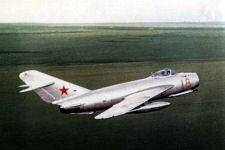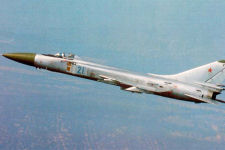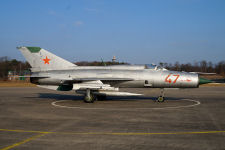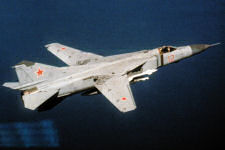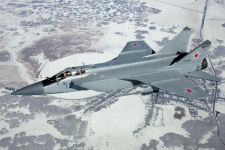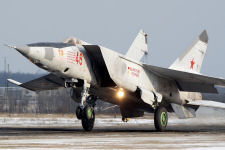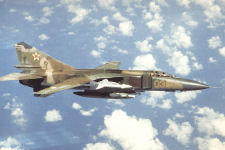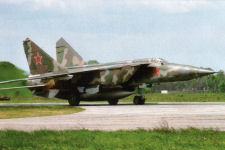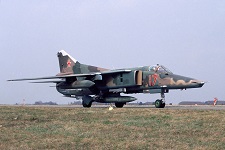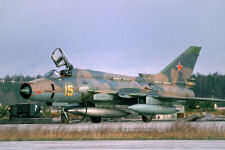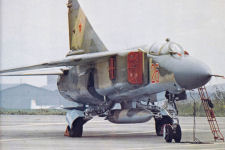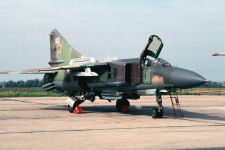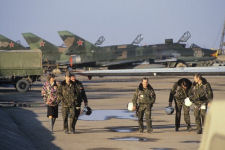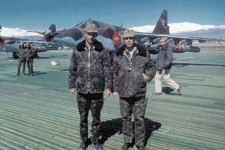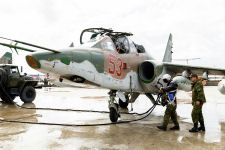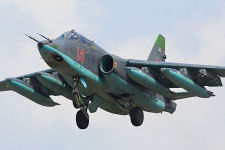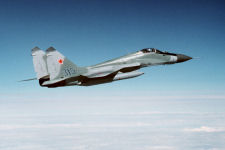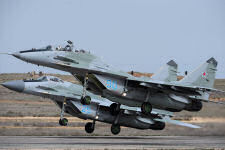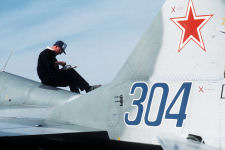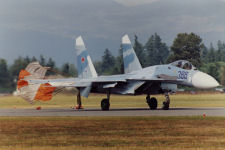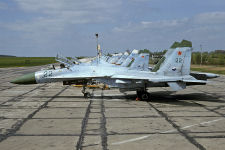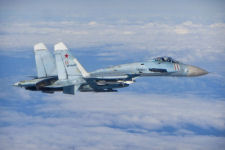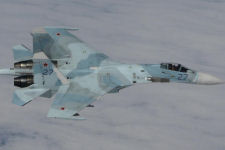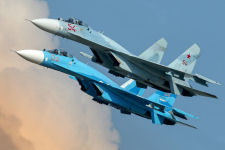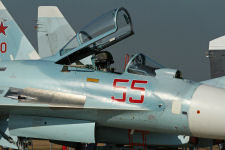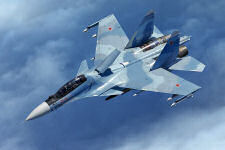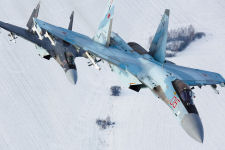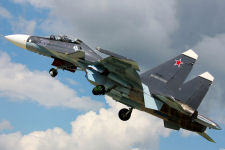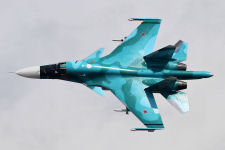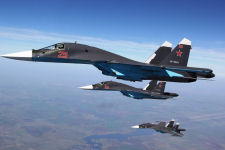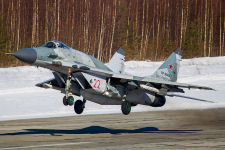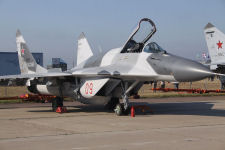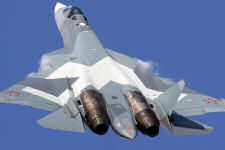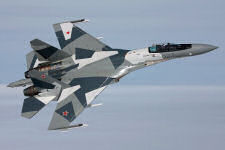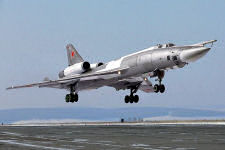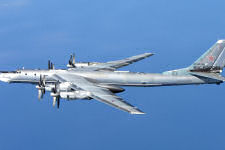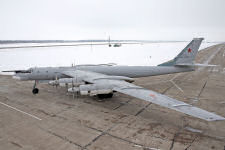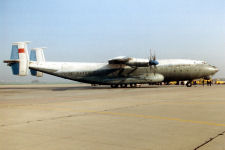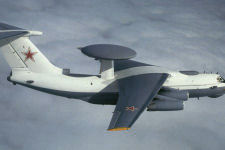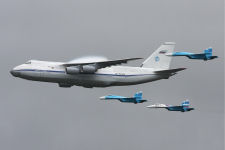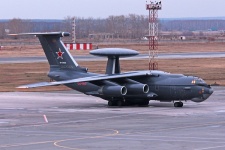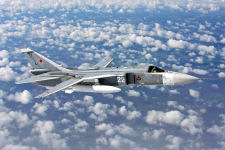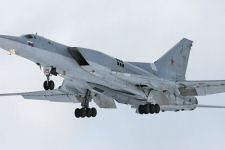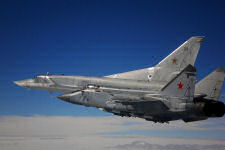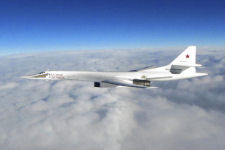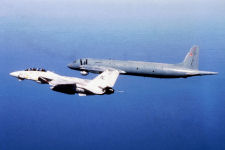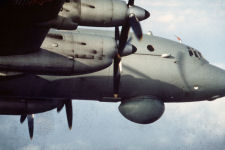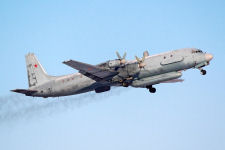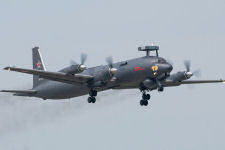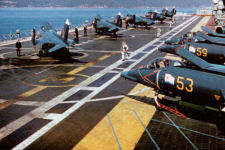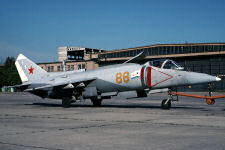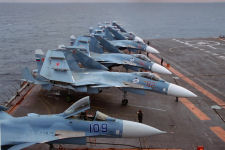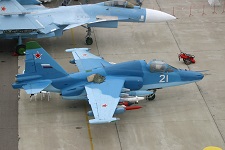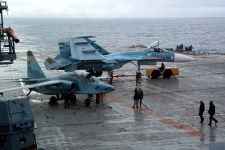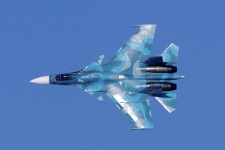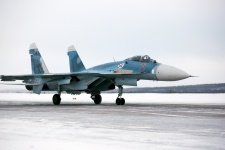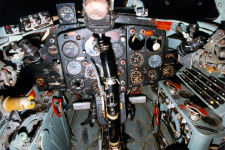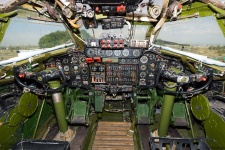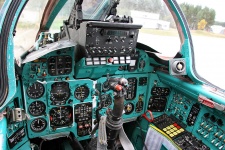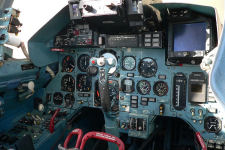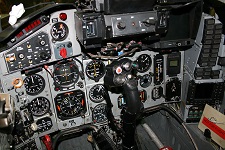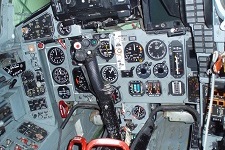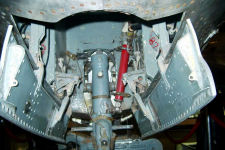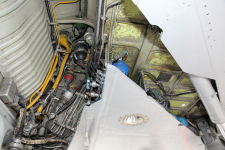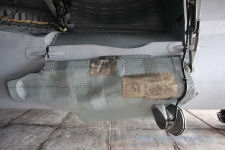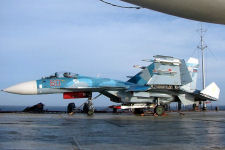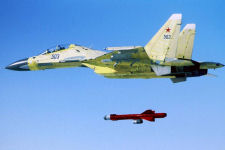Aircraft Colors and Camouflage, Soviet/Russian Air Force and Navy (Modern)
![]()
![]()
Introduction
As a society based around secrecy, it is no surprise how little is known about the minutiae of Cold War-era Soviet (and later Russian) aviation colors. Unlike World War II where a formal designation system was used for its palette, nothing of the sort appears to have existed or made public in the post-war period. Complicating the matter is that Soviet/Russian colors often vary considerably across photographs, even when discounting potential lighting/exposure issues and fading. What little is known (by the author) is that Soviet/Russian colors are based on a limited palette supplied by numerous manufacturers, and rather than matching one particular color (for example, from a color ship or pigment mix), these colors were intended to fall within an acceptable range of tolerance. In other words, all colors have two samples and any shade that falls in between is good enough. With different factories ordering paints from different manufacturers, you have a collage of visibly different colors which are ultimately the same intended ones.Unfortunately, preciously few quality color photographs exist (or rather, have been made public) for the Cold War era, many of the few we have were taken by Western air forces when intercepting a Soviet aircraft. For much of the Cold War, Soviet aircraft were left in their natural metal, with relatively austere markings. Then from the 1960s onward, Soviet aircraft tended to use relatively simple, two-tone schemes for "high-flying" aircraft like interceptors, bombers, and other strategic aircraft coupled with very complex camouflage schemes for "low-flying" aircraft like ground attackers and fighter-bombers which could have as many as five different topside colors in earthly tones. The introduction of the MiG-29 and Su-27 fighters in the 1980s added design-specific schemes which have continued to this day. There has also been considerable experimentation in the post-Soviet period, and Russian aerospace companies have been very aggressive in marketing their aircraft in the export market. This has resulted in a wide array of visually striking schemes seen on prototype and demonstrator aircraft, though few of these schemes have been adopted in service (and are mostly outside the scope of this page). Unlike other air forces which tend to repaint their existing inventories as new schemes are introduced, Soviet/Russian aircraft tend to retain the original schemes. This means long-serving aircraft like the MiG-25, Su-24, or Tu-95 are still seen today with schemes that are broadly unchanged from when they were first observed in the 1960s and 1970s.
Although as much photographic evidence as possible will be provided to back up the information, more than with any other country a disclaimer must be made that none of the information on this page is "official" and may contain errors. Additionally, none of the names given to schemes and paints are official either and in most cases I have given them generic names, aside from a small number of widely-used colors (which I have prefixed 'Russian') or design-specific colors (which I have prefixed by their aircraft code name like 'Fulcrum' or 'Flanker'). Please contact me if you have links to official documentation so that this page can be made more accurate.
A general note on model paints on Russian subjects:
Lack of an official palette has meant that Russian colors are woefully underserved by major paint manufacturers; for example, there is not a single Russian color in the entire Gunze acrylic range. Fortunately, this has begun to change, with newer ranges offering at least the basic colors and in some cases, even the more complicated tactical camo colors. By far the best source is AKAN, a Russian-based model paint manufacturer that has been praised for its accuracy with respect to Soviet/Russian colors and allegedly matches its paints with official factory swatches. However, AKAN also has a habit of producing different paints for even the most subtle color difference which adds to further confusion. Nevertheless, a full AKAN color table is included at the end of this page as it is without a doubt the most comprehensive set of post-war Soviet/Russian model paints available today and I have based some of the information on this site on their range. The relatively new but also highly-regarded Mr. Paint also has a large offering of matches. Other ranges with a respectable repertoire of Russian/Soviet colors include Hataka, Vallejo (recently added), and Xtracolor (though sadly not Xtracrylix).
Note: this page is based strongly on visual evidence and conjecture. It is intended solely as a guide for the modeler and not as an authoritative statement on Soviet/Russian colors and camouflage schemes.
Contents:
- Tactical
- Tactical NMF schemes (1940s-1980s)
- Interceptors (1970-Current)
- Tactical camouflage (1960s-Current)
- Late Frogfoot shemes (2006-Current)
- Fulcrum scheme (1984-Current)
- Flanker scheme (1985-Current)
- Mod Flanker schemes (2004-Current)
- Advanced Flanker schemes
- Fullback scheme (2013-Current)
- Splinter camouflage (2000s-Current)
- Strategic
- Naval
- Other
Paint guide basics:
All colors in this page include a paint chart with matches or equivalences from 19 different model paint ranges. Paints are considered matches if they are labeled with the intended color (either uniquely on together with another color). Paints are considered equivalences if they are close to the intended color but not labeled as such. The accuracy of any paint is independent of whether it is a match or an equivalence and these are described in the text (there can be poor matches and highly accurate equivalences). The following nomenclature is used in the paint tables and is based on matches or equivalences to US Insignia Red FS 11136:
| Paint | Match or equivalence type (label) |
| MP01 | Labeled to match one specific color (FS 11136) |
| MP02* | Labeled to match more than one color of same-country standards (FS 11136 / ANA 509)* |
| MP03** | Labeled to match more than one color of different-country standards (FS 11136 / BS 538) |
| MP04 (!) | Questionable accuracy of label match (doesn't look like FS 11136) |
| MP05 (?) | Questionable accuracy of label match, untested (doesn't look like FS 11136 in the bottle) |
| (MP06) | Close equivalent to FS 11136 (BS 538) |
| (MP07) (?) | Questionable equivalent to FS 11136 (Generic Gloss Red) |
* A single asterisk also denotes implicit matches for same-country standards where there is an official succession between standards. For example, H327* would match ANA 509 even if the label only references FS 11136 since ANA 509 is its official predecessor. This does not apply when there are considerable differences between successive paints (ex: Olive Drab No. 41/ANA 613/FS 34087) and this will be described in the text. By and large, however, single asterisk matches should be considered close enough to unique matches as to not be seriously questioned.
The paint charts make no distinction between gloss, semi-gloss, and matt variants of a color if the correct sheen is unavailable (ex: gloss FS 11136 will be a specific match for matt FS 31136 if the latter does not exist in the same paint range). Exceptions are made where there is a known or suspected color difference (ex: FS 24087 and 34087).
![]()
![]()
TACTICAL
Tactical natural metal scheme (1940s-1970s)
After World War II, the VVS began leaving both its tactical and strategic aircraft in their natural metal finish (NMF). Additionally, there was little in the way of unit identification although in some cases aircraft were given modest decorative elements, usually in red but occasionally in blue or yellow. One notable use of additional markings was during the 1968 invasion of Czechoslovakia, where participating aircraft were painted with two red stripes across the middle of the fuselage. Aside from these cases, the vast majority of Soviet tactical aircraft during the first half of the Cold War were decidedly plain in appearance, with the NMF interrupted only by radomes and dielectric panels which were typically painted Radome Green. Radome Green is a medium green which is also similar to the color used on post-war Soviet wheel hub caps although in practice, there is some variation and it is likely that the color actually used is an approximation. Some caps appear closer to an olive green and others like bronze green. The color is simlar to JASDF Light Green.
All early Mikoyan aircraft were left in NMF including the MiG-9, MiG-15, MiG-17, MiG-19, as well as early versions of the MiG-21 (MiG-21F/F-13/P/PF/PFM) with some later units also retaining the scheme. All purpose-built interceptors before the MiG-25 were left in NMF. Early ground attack aircraft were also in NMF including the Su-7 and Su-17M (all further versions used tactical schemes).
Paint guide:
- Aluminum: Any basic aluminum will do, and as with many NMF aircraft many showed darker or lighter shades of aluminum across the different panels.
- Radome Green: This is found in a number of newer ranges, and is also closely approximated by Gunze H319/C319. Most ranges equate radome green and wheel hub cap green, with the caveat that some caps looked a bit different.
- Others: The red, blue, or yellow used occasionally for markings are basic colors as well.
Links:
- Question on Su-27 wheels (ARC Forums)
- Mig-21 nose cone and green antenna areas (Britmodeller)
| Radome Green | Aluminum | |
| Schemes | ||
| Basic | Radome / Dielectric / Wheel caps | Overall |
| Color matches | ||
| Gunze Aqueous | (H319) | (H8) |
| Gunze Mr. Color | (C319) | (C8) |
| Humbrol | - | 56 |
| Model Master | - | 1781 |
| Revell | - | 99 |
| Tamiya | - | XF-16 |
| Vallejo Model Air | - | 71.062 |
| Vallejo Model Color | - | - |
| AKAN | 73060 | 76004 |
| AK Interactive | AK-2302 | - |
| AK Real Colors | - | RC-020 |
| AMMO by Mig | - | A.MIG-194 |
| Colourcoats | - | - |
| Hataka | HTK-327 | HTK-078 |
| Lifecolor | - | LC-74 |
| Mission Models | - | MMM-003 |
| Mr. Paint | MRP-32 | MRP-3 |
| Xtracolor | X628 | X142 |
| Xtracrylix | - | (XA1216) |
Interceptors (1970s-Current)
With the introduction of the MiG-23 'Flogger', interceptor aircraft in the VVS switched to a new scheme that was based around a neutral, medium gray that has become sufficiently ubiquitous as to be referred herein as Russian Gray. It varies wildly in terms of brightness, and it has been suggested that two separate versions of the paint (a standard and a light version) have been used. At its darkest it resembles FS 36270 but in its lightest version is more like FS 36373. Another change in the scheme was that the radomes and dielectric panels were typically painted in Radome Gray, a dark gray, sometimes looking similar to FS 36118 at its darkest or FS 36152 and RLM 75 at its lightest. As was common with interceptors, black anti-glare panels were also painted in front of the cockpit though not on the MiG-23 given its role as a fighter rather than an interceptor. It was common for the VVS to maintain a large inventory of previous-generation aircraft during the Cold War, but it was not common practice to repaint them to these newer schemes. As such, older interceptors like the Su-15 and Tu-28 that remained in service into the 1980s retained their natural metal finish. Most were withdrawn after the dissolution of the USSR in 1991.
The MiG-23 was the first aircraft to introduce this new scheme, although only for some early fighter (MiG-23S/M/ML) and interceptor units (MiG-23P); all others, most notably fighter-bomber and attack units as well as later fighters, sported tactical camo schemes (see below). All interceptor versions of the MiG-25 as well as most reconnaissance/recon-bomber aircraft were painted in this scheme, although a small number of the latter were seen during the Cold War in tactical camo schemes as well. The MiG-31 has used this scheme exclusively since its introduction.
Paint Guide:
- Russian Gray: Paint manufacturers have been late in bringing to the market Russian-specific colors and despite it being the most widely used color on Soviet/Russian aircraft since World War II, Russian Gray is only found in a small number of newer ranges although was recently introduced by Vallejo (as Russian Gray N.3, 71.339) in line with other modern Russian offerings. Both AKAN and AK Real Colors make good versions, with the former being the darker of the two. Mr. Paint offering two different paints, the first known as Traffic Gray (MPR-189) which is labeled for the MiG-31 while Russian Air Superiority Gray AS1115 (MRP-354) is labeled for MiG-21/23s, with AS-1115 referring to the brand that supplied the Gorky factory where these aircraft were built. Colourcoats also offers two versions, its Gray (ACSM06) is labeled for early Mikoyan interceptors while another Blue Gray (ACSM05) is also labeled for the MiG-31/Su-24/Tu-22M. I suspect the latter is more appropriate for the bluer patrol scheme color (see Patrol section) and so only ACSM06 will be matched to Russian Gray.
- Radome Gray: Radome Gray exists in the vacuum of darker-than-medium but lighter-than-dark grays. It strongly resembles the color of darkened F-16 radomes to which I have found Gunze's H306/C306 (which does not remotely resemble its intended match of FS 36118) to be an acceptable substitute. AKAN, Hataka, and Mr. Paint are also the only ones to offer a specific Radome Gray paint.
| Radome Gray | Russian Gray | |
| Schemes | ||
| Basic | Radome / Dielectric | Overall |
| Color matches | ||
| Gunze Aqueous | (H306) | - |
| Gunze Mr. Color | (C306) | - |
| Humbrol | - | - |
| Model Master | - | - |
| Revell | - | - |
| Tamiya | - | - |
| Vallejo Model Air | - | 71.339 |
| Vallejo Model Color | - | - |
| AKAN | 73010 | 73059 |
| AK Interactive | - | - |
| AK Real Colors | - | - |
| AMMO by Mig | - | RC-336 |
| Colourcoats | ACSM08 | ACSM06 |
| Hataka | HTK-231 | - |
| Lifecolor | - | - |
| Mission Models | - | - |
| Mr. Paint | MRP-47 | MRP-189 / MRP-354 |
| Xtracolor | X627 | - |
| Xtracrylix | - | - |
Tactical camouflage (1970s-Current)
The 1970s saw the VVS also introduce tactical camouflage schemes for ground attack aircraft as well as fighters that were involved in attack, close support or other types of low level operations. There is preciously little official information about the actual specifications of these schemes as well as the colors used, the only source being a translation of an official VVS 1974 specification by the IPMS Netherlands (see link). According to the 1974 specification, camouflaged aircraft would be painted in two- to five-tone schemes with blue undersides. These schemes would vary considerably among units and even within aircraft of the same unit. Colors could be picked from a palette of five basic topside camo colors (two greens and three browns), as well as two blues for the undersides.
The colors chosen would largely depended on the region that the aircraft was based, with temperate regions requiring darker, greener schemes compared to aircraft based in drier or desert regions (like Central Asia) whose schemes would be lighter, and browner. Additionally, there were separate summer and winter variants for each of these schemes. Despite the wide variety of schemes used, most patterns tended to be of similar style depending on the aircraft type. For example, the patterns used on MiG-25 are much more irregular and jagged, compared to the smoother curves of the MiG-23, or the wavier patterns on the Su-25 which was also notable for having very high demarcations between the topside and underside colors.
- Protective Green: Known officially as Protective, this is a very dark green that may look brownish from certain angles. It closely resembles RLM 70 when freshly painted and FS 34079 when faded.
- Light Green: Despite being described as a light green, it was darker than the name suggests and is vaguely similar to RLM 82 or even ANA 611 depending on photograph. Many aircraft show a a light olive color, and it is unclear whether this is the color that resulted after fading or whether it was a different factory mix.
- Brown: This is a dark brown, often described as a chocolate or chestnut brown and is lighter than Protective when contrasted. This is similar to the brown variant of RLM 81.
- Sand: This is not so much a sand as it is an earth brown, somewhat resembling RAF Dark Earth. Tends to fade considerably into an ochre-like color.
- Light Sand: This is a somewhat generic, darkish beige and does not seem to match any color from the better known Western palettes, although the light brown used by the JASDF appears closest. Some aircraft show a much lighter color more similar to a yellow sand. It is not clear whether this represented a very faded version of the original or is a separate mix.
Regarding the underside colors, the basic one in use is Light Blue, presumably similar to the one used in the Korean War-era tactical scheme and close to RLM 65. Gray-blue was also used as an underside color, though less commonly, and more closely resembles RLM 76. Additionally, aircraft based in northern latitudes or in special winter schemes also used white as a topside camouflage color. These aircraft were rare (I have not encountered a color photograph), probably because most tactical units were based closer to European and Central Asian fronts.
Soviet aircraft were frequently retouched in the field. The freshly painted colors often contrasted with the faded originals giving the appearance of different paints. More confusingly, touch ups could be applied only to areas that required repainting which resulted in patchy paintwork, or they would involve repainting just one existing color which means that many aircraft sported a combination of fresh and faded colors. In many cases, however, unique touch-up colors were used that were indeed different than the official ones. The most noticeable of these is a Bright Green that somewhat resembles the traditional color used in many Russian houses (the IPMS source calls it "dacha green"). Another frequently used color is an Ochre Brown, which appears close to a reddish brown like RAL 8012. It was also widely used in some Warsaw Pact forces, notably Czechoslovakia.
Additionally, radomes and dielectric panels tended to be Radome Gray or Radome Green, the former being more common on MiG-23/25/27s while the latter was seen more commonly on Su-17/25s. Radome White was also sometimes used.
Mikoyan aircraft that used tactical camo schemes included the late versions of the MiG-21 (SMT/bis); ground attack versions of the MiG-23 (BN) including the dedicated MiG-27 as well as late fighters with attack capability (M/MLD); a small number of recon-bomber versions of the MiG-25 (RB/RBV); and early MiG-29 aircraft based east of the Urals. Sukhoi aircraft included the Su-17/22M4 (earlier versions were natural metal) and the Su-25, which is the only Russian aircraft to retain a tactical camo scheme today given the retirement of most other aircraft. Early Su-24s also used a two-tone (Light Sand/Sand) during the 1970s but quickly evolved into the bomber scheme mentioned below.
Paint guide: AKAN and Mr. Paint are the only range to carry Soviet tactical colors, although confusingly they do not seem to follow the conventions of the 1974 specification. AKAN has released six sets of tactical camo paint in their acrylic range, plus one specific to their lacquer range. AKAN typically provides two different versions of each paint, one representing the standard tactical colors (labeled '1960s-XXI') while another represents Afghanistan War era aircraft (labeled '1978-1989'). The latter are presumably intended to represent faded, worn out colors from aircraft in the combat zone. Unfortunately, neither set includes representations of the five basic colors since there's only one green included. Two colors, Protective and Light Sand have only one equivalent but all others have their basic and Afghanistan versions, the latter which are all slightly lighter. The Light Green equivalent (73055) is also notably absent from most sets, although it is included in the MiG-29 9.13 set (No. 47344). It's lightened equivalent (73099) is also the one which is most notably different from the original color, having a pronounced olive tint. Two sets also include Reddish (73025, also labeled as Red or Golden Brown) which likely represents ochre brown. , a red brown similar to RAL 8012. This does not appear to represent an official VVS color, but does look like some touch up colors seen on some aircraft as well as some Warsaw Pact schemes. No set includes the ubiquitous 'dacha green', although a basic bright green could be an effective substitute.
Although most AKAN paints with lacquer equivalents only change their first digit, there are three unique lacquer colors (63012, 63013, and 63014) which are included in a unique set (No. 46315). They appear to have mild variations from their acrylic equivalents, being slightly lighter given that they are labeled as faded. Another set (No. 47320) includes modern Su-25 colors which are described in the next section, but included here for comparison purposes. The following chart summarizes the main AKAN Soviet/Russian tactical camo sets.
Links
| Protect. Green | Light Green | Brown | Sand | Light Sand | Other | Lower | ||
| 46314 47314 |
USSR (1978-1989) | |||||||
| 73099 | 73098 | 73097 | 73096 | 73023 | ||||
| 46315 | USSR (1978-1989) | |||||||
| 63013 | 63012 | 63014 | 63016 | |||||
| 46316 47316 |
USSR/Russia (1960-XXI) | |||||||
| 73024 | 73026 | 73080 | 73025 | 73008 | ||||
| 47320 | Su-25 (after 2006) | |||||||
| 73143 | 73142 | 73141 | 73140 | 73145 | ||||
| 46344 47344 |
MiG-29 9.13 | |||||||
| 73024 | 73055 | 73080 | 73096 | |||||
| 47357 | Su-22 (1978-1989) | |||||||
| 73099 | 73098 | 73097 | 73096 | 73023 | ||||
| 47358 | Su-22 (1978-1989) | |||||||
| 73024 | 73026 | 73080 | 73025 | 73023 |
Mr. Paint also includes the (near full) range of tactical camo colors, thankfully without the multiple subtle versions of AKAN's range but confusingly listed in their Czech rather than Soviet/Russian color range. They are also named differently from the 1974 specification but their equivalents are included in the scheme chart below. Absent is Light Sand, although MRP-162 could be a close substitute. Recently, Vallejo has also introduced numerous tactical camo sets, although following Vallejo tradition, most colors are not Soviet/Russian-specific matches. As a result, accuracy is suspect. Hataka also has various sets for Warsaw Pact aircraft including MiG-29s and Polish Su-22s but, like Vallejo, use equivalents from other ranges. Unless specifically matched, these colors are included in parenthesis below.
As a final caveat, there is an unfortunate shortage of Afghanistan War color photographs, and most of the ones that exist suffer from brightness and exposure issues. The grand majority of photos are in black and white and many modeling resources (painting instructions, color profiles) appear to be based on aircraft that only have black and white sources. As such, many of these color schemes should be taken with a pinch of salt.
| Light Blue | Gray-Blue | Protective Green | Light Green | Light Green (Faded ?) | Bright Green | |
| Schemes | ||||||
| VVS | Lower (1) | Lower (2) | Upper Camo | Upper Camo | Upper Camo | (Upper Camo) |
| Color matches | ||||||
| Gunze Aqueous | - | - | - | - | - | (H26) (?) |
| Gunze Mr. Color | - | - | - | - | - | (C66) (?) |
| Humbrol | - | - | - | - | - | - |
| Model Master | - | - | - | - | - | - |
| Revell | - | - | - | - | - | - |
| Tamiya | - | - | - | - | - | - |
| Vallejo Model Air | 71.332 | (71.046) | 71.347 | 71.341 | (71.081) | - |
| Vallejo Model Color | - | - | - | - | - | - |
| AKAN | 73008 / 73016 | 73023 | 73024 / 63013 | 73055 | 73099 | - |
| AK Interactive | - | - | - | - | - | - |
| AK Real Colors | - | - | - | - | - | - |
| AMMO by Mig | - | - | - | - | - | - |
| Colourcoats | - | - | - | - | - | - |
| Hataka | (HTK-150) | - | (HTK-016) | (HTK-091) | - | - |
| Lifecolor | - | - | - | - | - | - |
| Mission Models | - | - | - | - | - | - |
| Mr. Paint | - | MRP-168 | MRP-164 | MRP-165 | - | - |
| Xtracolor | - | - | - | - | - | - |
| Xtracrylix | - | - | - | - | - | - |
| Brown | Sand | Light Sand | Ochre Brown | Yellow Sand | |
| Schemes | |||||
| VVS | Upper Camo | Upper Camo | Upper Camo | (Upper Camo) | (Upper Camo) |
| Color matches | |||||
| Gunze Aqueous | - | - | - | - | - |
| Gunze Mr. Color | - | - | - | - | - |
| Humbrol | - | - | - | - | - |
| Model Master | - | - | - | - | - |
| Revell | - | - | - | - | - |
| Tamiya | - | - | - | - | - |
| Vallejo Model Air | (71.282) | (71.246) | (71.244) | (71.032) | (71.143) |
| Vallejo Model Color | - | - | - | - | - |
| AKAN | 73026 / 73098 / 63012 | 73080 / 73097 / 63014 | 73096 | 73025 | 73141 |
| AK Interactive | - | - | - | - | - |
| AK Real Colors | - | - | - | - | - |
| AMMO by Mig | - | - | - | - | - |
| Colourcoats | - | - | - | - | - |
| Hataka | (HTK-087) | (HTK-188) | (HTK-306) | - | - |
| Lifecolor | - | - | - | - | - |
| Mission Models | - | - | - | - | - |
| Mr. Paint | MRP-166 | - | - | MRP-167 | - |
| Xtracolor | - | - | - | - | - |
| Xtracrylix | - | - | - | - | - |
Late Frogfoot schemes (2006-Current)
The end of the Cold War saw the new Russian Air Force inherit large quantities of obsolete Soviet aircraft like the MiG-23 and Su-17, without the funds for keeping them in service. As a result, the 1990s saw a massive retirement of aircraft, many of which had been those which carried tactical camouflage. The VVS therefore ended with just one major type for each specific tactical role, with the relatively new Su-25 being chosen as the main close support aircraft. It is not clear if the Cold War-era five-tone standards remained in place in the 21st century, in light of what appears to be the widespread use of a yellow sand that was seen sporadically in Soviet times. Another new color was a green-gray, which was somewhat in between the older green and protective colors and may simply be a different factory variant rather than an intended new color altogether. Other colors are similar to the standard tactical camo colors listed above.
Recent Su-25s are seen sporting the traditional light blue and gray-blue undersides as well as white undersides, which is otherwise unique among Russian tactical camo aircraft. Like many Flankers, new variants have been seen in an eggplant scheme, with Dark Eggplant Gray over light blue or white. This has seen mostly in the Su-25SM variant.
The paint chart below only includes the new or unique colors to the modern Su-25.
Paint guide: AKAN has a paint set for recent Su-25s (No. 47320) with four camo colors. Of these, the light sand and brown are nearly identical to earlier schemes, the novelties being the green gray (73143) and yellow sand (73140) as well as the underside gray blue (73141), which is a slightly cooler version of the older one.
| White | Gray-Blue | Light Blue | Yellow Sand | Green-Gray | Dark Eggplant Gray | |
| Schemes | ||||||
| Basic | Lower (1) | Lower (2) | Lower (3) | Upper Camo | Upper Camo | |
| Eggplant | Lower (1) | Lower (2) | Upper | |||
| Color matches | ||||||
| Gunze Aqueous | (H21) | - | - | - | - | - |
| Gunze Mr. Color | (C69) | - | - | - | - | - |
| Humbrol | - | - | - | - | - | - |
| Model Master | - | - | - | - | - | - |
| Revell | - | - | - | - | - | - |
| Tamiya | - | - | - | - | - | - |
| Vallejo Model Air | - | - | 71.332 | (71.143) | - | (71.049) |
| Vallejo Model Color | (70.820) | - | - | - | - | - |
| AKAN | 73146 | 73145 | 73008 / 73016 | 73025 | 73143 | 73166 |
| AK Interactive | - | - | - | - | - | - |
| AK Real Colors | (RC-013) | - | - | - | - | RC-242 |
| AMMO by Mig | - | - | - | - | - | - |
| Colourcoats | - | - | - | - | - | - |
| Hataka | (HTK-101) | - | (HTK-150) | - | (HTK-151) | HTK-230 |
| Lifecolor | - | - | - | - | - | - |
| Mission Models | - | - | - | - | - | - |
| Mr. Paint | - | - | - | - | MRP-165 | MRP-205 |
| Xtracolor | - | - | - | - | - | - |
| Xtracrylix | - | - | - | - | - | - |
Fulcrum scheme (1984-Current)
The introduction of the MiG-29 'Fulcrum' in 1984 marked the beginning of the use of aircraft-specific schemes on Russian/Soviet aircraft. The MiG-29 featured a very attractive two-tone scheme involving an overall coat of Fulcrum Gray with a topside camouflage of Fulcrum Gray-Green. Fulcrum Gray appears at first glance to be similar to the standard Russian Gray used in earlier fighters but is actually slightly darker and with similar if not greater changes in brightness. Likewise, Fulcrum Gray-Green has considerable variation though less so than the gray, and a small number of early aircraft appear to have sported a different, more traditional green. Given that the Fulcrum was very secretive during its first years in Soviet service (it was not seen by Western audiences until the late 1980s, notably at the Farnborough Air Show in 1988), its topside camo was frequently believed to be a darker gray or even a gray-blue.
MiG-29s used Radome Gray for its radome and dielectric panels with hardly any exceptions. The basic Fulcrum scheme was used on both early MiG-29 (9.12) as well as MiG-29S (9.13) versions, although the more modern MiG-29SMT uses a new splinter scheme described below.
Paint guide:
- Fulcrum Gray / Gray-Green: The Fulcrum colors are, thankfully, much better represented now after decades of neglect. AKAN makes a spot on version of Fulcrum Gray-Green although its Fulcrum Gray appears a bit took dark. Mr. Paint's equivalents look accurate and are probably the best matches. Vallejo introduced a Fulcrum Gray-Green but not a Fulcrum Gray, and uses a US equivalent in its MiG-29 set. Fulcrum Gray-Green has no remote FS approximation but German Field Gray (RAL 7009) is possibly the closest among the major Western palettes.
| Fulcrum Gray | Fulcrum Gray-Green | |
| Schemes | ||
| Basic | Overall | Upper Camo |
| Alternative | Overall | Upper Camo |
| Color matches | ||
| Gunze Aqueous | - | - |
| Gunze Mr. Color | - | - |
| Humbrol | - | - |
| Model Master | 2133 | 2134 |
| Revell | - | - |
| Tamiya | - | - |
| Vallejo Model Air | (71.277) | 71.340 |
| Vallejo Model Color | - | - |
| AKAN | 73092 | 73093 |
| AK Interactive | - | - |
| AK Real Colors | RC-337 | RC-338 |
| AMMO by Mig | - | - |
| Colourcoats | ACSM04 | ACSM05 |
| Hataka | - | - |
| Lifecolor | - | - |
| Mission Models | - | - |
| Mr. Paint | MRP-91 | MRP-92 |
| Xtracolor | X612 | X611 |
| Xtracrylix | - | - |
Flanker scheme (1985-Current)
Shortly after the Fulcrum was introduced came the Su-27 'Flanker', and with it one of the most attractive camouflage schemes of any fighter. Meant as a long-range air superiority fighter and interceptor, the Flanker featured a three-tone pattern that remains in use to this day and has also served as a template for almost all other Flanker schemes. The base color consists of Flanker Light Blue, a pastel-like pale blue. The topside is disrupted with Flanker Light Gray and Flanker Medium Blue. The former is a light blue-gray that has a slight purplish tone, and blends very subtly with the base color. The latter is a bright blue, somewhat close the USAF's Air Superiority Blue (FS 35450) when faded, although it was noticeably darker when fresh. The camo pattern tended to have a layered look, with Flanker Blue typically painted over larger areas of Flanker Blue-Gray, although in some cases it was applied directly over the Flanker Pale Blue. The overall effect of these three colors is stunning to say the least, giving the Su-27 an elegant, serene appearance that belies its awesome capabilities. The basic scheme is seen in the Su-27 fighter, Su-27P interceptor, and Su-27UB two-seater.
Flankers tended to use all three main radome/dielectric colors, with Radome White and Radome Green being the more common ones. However, the Flanker introduced a new Radome Light Gray color as well, which was less common in early aircraft compared to later advanced versions like the Su-30/35 (see below). It was also not uncommon to see them with different colored dielectric panels compared to the radomes. Also unique to the Flanker is the use of red for the interior of landing gear covers and air brakes (see the interiors section).
A few Flanker units are known to use schemes considerably different from the standard ones, notably the ones based in Belbek airbase in the Crimea following the Russian annexation.
Paint guide:
- Flanker Light Blue / Light Gray / Medium Blue: After years of neglect, it is encouraging to see that the Flanker scheme is now much better represented. AKAN and Mr. Paint are arguably the gold standard, with the latter showing slightly higher contrast. Vallejo has also recently offered Flanker-specific paints although I cannot vouch for accuracy. Hataka offers the full range, but only the light blue (HTK-328) is specifically matched to the Flanker scheme. Finally it worth mentioning the two ranges that offered the Flanker scheme before everyone else: Model Master and Xtracolor. Both appear too dark, although strangely enough, Xtracolor is so much darker that it appears closer to the current Su-33 scheme. Model Master's version of the darker color (2132) is so dark it looks more like the Sukhoi cockpit color. As for Radome Light Gray, only AKAN has a direct match, but any generic neutral light gray is probably suitable with the consideration that it faded considerably in use.
- Radome Light Gray: The radome color on Flankers is noticeably lighter than the normal Radome Gray, and also seemingly lighter than the sole AKAN match to it. Any light neutral gray should be a good enough approximation, however. With many models using decals for fuselage dielectric panels, perhaps the best best is to make a custom mix to match them so that they appear homogeneous.
Links
| Radome Light Gray | Flanker Light Blue | Flanker Light Gray | Flanker Medium Blue | |
| Schemes | ||||
| Early | Radome / Dielectric | Overall | Upper Camo | Upper Camo |
| Color matches | ||||
| Gunze Aqueous | - | - | - | - |
| Gunze Mr. Color | - | - | - | - |
| Humbrol | - | - | - | - |
| Model Master | - | 2130 | 2131 (!) | 2132 (!) |
| Revell | - | - | - | - |
| Tamiya | - | - | - | - |
| Vallejo Model Air | - | 71.334 | 71.335 | 71.337 |
| Vallejo Model Color | - | - | - | - |
| AKAN | 73105 | 73035 | 73036 | 73046 |
| AK Interactive | - | - | - | - |
| AK Real Colors | - | - | - | - |
| AMMO by Mig | - | - | - | - |
| Colourcoats | - | ACSM01 | ACSM03 | ACSM02 |
| Hataka | - | HTK-328 | (HTK-038) | (HTK-095) |
| Lifecolor | - | - | - | - |
| Mission Models | - | - | - | - |
| Mr. Paint | - | MRP-197 | MRP-198 | MRP-196 |
| Xtracolor | - | X602 (!) | X603 (!) | X601 (!) |
| Xtracrylix | - | - | - | - |
Mod Flanker schemes (2004-Current)
The Su-27SM is a major modernization of existing Flanker airframes in order to make them competitive in the 21st century. They can be told apart by the starboard position of the IRST module in front of the cockpit (in the basic Flanker it is centered). The Su-27SM features subtly different representations of the three basic Flanker colors, with the main obvious difference being that the Light Gray seems to contrast more with the Light Blue. The darker Medium Blue, like its previous incarnation, seems to vary in brightness in different photographs. Overall, the scheme seems to have a very slight greenish tint compared to the earlier and later ones. Most Su-27SMs have been seen with white radomes and dielectric panels, although a few have been painted with green panels as well.
For a brief period in the late 2000s, a number of Su-27SMs were seen with a stunning bright blue two-tone scheme, arguably the most eye-catching scheme ever seen on a Flanker. The two colors appear to be somewhat similar to the darker two colors used on the current Su-33 scheme, while the base color also shares similarities with that of the Russian Knights demo team. Most Su-27SM have since reverted to the basic three-tone pattern, and are also using the newer colors seen on the Su-30/35 (see below).
Paint guide:
- Flanker Light Blue / Light Gray / Medium Blue (2): The Su-27SM early colors are similar enough to both the basic and the later schemes that most modelers will probably not be bothered in sourcing or mixing specific paints. For those looking for strict accuracy, only AKAN offers specific paints (set No. 47332).
- Bright Blue / Bright Dark Blue: Vallejo offers a match for the dark blue while using an AII match for the lighter one which appears very close. Otherwise, the closest equivalents are probably those used on the Su-33 and those are the colors that are matched here in parenthesis. A generic deep sky blue could work for the lighter color as well as a medium blue for the darker one, with Vallejo Model Color also having two very similar colors in their range (provided in parenthesis).
| Flanker Light Blue (2) | Flanker Light Gray (2) | Flanker Medium Blue (2) | Bright Blue | Bright Dark Blue | |
| Schemes | |||||
| Basic | Overall | Upper Camo | Upper Camo | ||
| Alternative | Overall | Upper Camo | |||
| Color matches | |||||
| Gunze Aqueous | - | - | - | - | - |
| Gunze Mr. Color | - | - | - | - | - |
| Humbrol | - | - | - | - | - |
| Model Master | - | - | - | - | - |
| Revell | - | - | - | - | - |
| Tamiya | - | - | - | - | - |
| Vallejo Model Air | - | - | - | (71.317) | 71.333 |
| Vallejo Model Color | - | - | - | (70.844) | (70.963) |
| AKAN | 73160 | 73162 | 73161 | (73164) | (73165) |
| AK Interactive | - | - | - | - | - |
| AK Real Colors | - | - | - | - | - |
| AMMO by Mig | - | - | - | (A.MIG-224) | (A.MIG-229) |
| Colourcoats | - | - | - | - | - |
| Hataka | - | - | - | (HTK-284) | (HTK-283) |
| Lifecolor | - | - | - | - | - |
| Mission Models | - | - | - | - | - |
| Mr. Paint | - | - | - | (MRP-199) | (MRP-200) |
| Xtracolor | - | - | - | - | - |
| Xtracrylix | - | - | - | - | - |
Advanced Flanker schemes (2010s-Current)
The multi-role Su-30SM and Su-35S are the most advanced variants of the Flanker currently in service with the VVS, offering true multi-role capability. Although both sport the traditional Flanker scheme, this has also been slightly modified to what is now the standard scheme on all Flankers, including Su-27SMs. Like the earlier Su-27SM scheme, there is much greater contrast between the Light Blue and the Light Gray compared to the early Flanker scheme. Furthermore, the two blues are noticeably cooler than their predecessors. They are also closer to their US Aggressor equivalents, particularly the Light Blue which is very similar to FS 35450 (Air Superiority Blue) while the Medium Blue resembles FS 35190. Aside from Flankers, this scheme is also found on the new Yak-130 trainer and can therefore be considered the "standard" blue three-tone of VVS aircraft at the end of the decade.
The Su-30 and Su-35 also introduced a simple but attractive new scheme that is often referred to as the "Eggplant" scheme, consisting of a new Dark Eggplant Gray which is a dark gray with a purple-ish tint. Undersides retain the base Light Blue color with a noticeable exception: naval Su-30s have undersides that sport a the full three-tone camouflage pattern, an oddity that is not seen in any other Eggplant scheme aircraft. This is not seen on VVS Su-30s, whose undersides are of a single color.
Another unique characteristic of Su-30/35 aircraft is the preference for Radome Light Gray radomes and dielectric panels. Although all Flankers have been seen with gray radomes, this has typically been the least common color, whereas it has now become the dominant one in both the three-tone and eggplant schemes. A large number of aircraft, however, do retain white radomes with green being virtually non-existent.
Paint Guide: Note that AKAN has recently introduced a new set with a different colors for naval Su-30SMs from 2019 as well as Su-35s built in the KnAAZ plant from 2019 with the new colors being (from lightest to darkest), 73190, 73192, 73191.
- Flanker Light Blue / Light Gray / Medium Blue (3): Both AKAN and Mr. Paint have dedicated matches for the new Flanker scheme. AKAN's offering comes in set No. 46332, which is sometimes labeled as just for newer Su-27SMs while other boxes also show it as suitable for Su-30/35s and Yak-130 trainers. Unfortunately, AKAN's appear too light: they are lighter in the bottle than their (excellent) original Flanker scheme paints, when the opposite should be the case. As such, the Mr. Paint offerings are probably better as they appear darker and deeper.
- Dark Eggplant Gray: The newest of major Russian colors has thankfully received considerable attention with AK Real Color and Hataka also offering its versions. This is a relatively easy color to get right and there appears to be a lighter version used on many helicopters which Hataka has a version of (HTK-296). Vallejo's version, also included in a helicopter set, is not specifically matched to the Russian color.
| Flanker Light Blue (3) | Flanker Light Gray (3) | Flanker Medium Blue (3) | Dark Eggplant Gray | |
| Schemes | ||||
| Basic | Overall | Upper Camo | Upper Camo | |
| Eggplant | Lower | Upper | ||
| Eggplant (Naval) | Lower Camo | Lower Camo | Lower Camo | Upper |
| Color matches | ||||
| Gunze Aqueous | - | - | - | - |
| Gunze Mr. Color | - | - | - | C393 |
| Humbrol | - | - | - | - |
| Model Master | - | - | - | - |
| Revell | - | - | - | - |
| Tamiya | - | - | - | - |
| Vallejo Model Air | - | - | - | (71.049) |
| Vallejo Model Color | - | - | - | - |
| AKAN | 73168 | 73169 | 73167 | 73166 |
| AK Interactive | - | - | - | - |
| AK Real Colors | - | - | - | RC-242 |
| AMMO by Mig | - | - | - | - |
| Colourcoats | - | - | - | - |
| Hataka | - | - | - | HTK-230 |
| Lifecolor | - | - | - | - |
| Mission Models | - | - | - | - |
| Mr. Paint | MRP-297 | MRP-296 | MRP-298 | MRP-205 |
| Xtracolor | - | - | - | - |
| Xtracrylix | - | - | - | - |
Fullback schemes (2010-Current)
The Su-34 'Fullback' is undoubtedly the most dramatic alteration of the basic Flanker airframe, producing one of the largest tactical aircraft currently in service anywhere in the world. The Su-34 departs from the traditional Flanker scheme by using turquoise tones that give it a somewhat more tropical maritime appearance. Also in a departure from Flanker tradition, no grays are used. The base color is Light Blue, which is similarly in brightness to other Flanker base colors but with a hint of green. It is strongly reminiscent of the World War II-era AMT-7. This is disrupted by a topside pattern of Medium Green-Blue and Dark Green-Blue, which are exactly as their name suggest, and do not appear to have equivalents with other Western palettes. Finally, like its Su-30/35 counterparts, the Su-34 has been seen sporting the Eggplant scheme of Dark Eggplant Gray over Light Blue.
Paint Guide:
- Fullback Light Blue / Green-Blue / Dark Green-Blue: The subtle changes in color for each new Flanker variant appears designed with no other ulterior purpose than to confuse modelers Thankfully, the Su-34 scheme is well represented by AKAN (set No. 47309), Hataka, and Mr. Paint. The rather generic nature of the three colors means that they are hard to get wrong and all three offerings appear at first glance to be quite close to the real thing. Lacking these, Light Blue is probably best approximated by AMT-7 although in practice it appears brighter. The remaining Green-Blues will probably have to be mixed.
| Fullback Light Blue | Fullback Green-Blue | Fullback Dark Green-Blue | Dark Eggplant Gray | |
| Scheme | ||||
| Basic | Overall | Upper Camo | Upper Camo | |
| Eggplant | Lower | Upper | ||
| Color matches | ||||
| Gunze Aqueous | - | - | - | - |
| Gunze Mr. Color | - | - | - | C393 |
| Humbrol | - | - | - | - |
| Model Master | - | - | - | - |
| Revell | - | - | - | - |
| Tamiya | - | - | - | - |
| Vallejo Model Air | - | - | - | - |
| Vallejo Model Color | - | - | - | - |
| AKAN | 73037 | 73038 | 73039 | 73166 |
| AK Interactive | - | - | - | |
| AK Real Colors | - | - | - | RC-242 |
| AMMO by Mig | - | - | - | |
| Colourcoats | - | - | - | - |
| Hataka | HTK-229 | HTK-228 | HTK-227 | HTK-230 |
| Lifecolor | - | - | - | - |
| Mission Models | - | - | - | - |
| Mr. Paint | MRP-202 | MRP-203 | MRP-204 | MRP-205 |
| Xtracolor | - | - | - | - |
| Xtracrylix | - | - | - | - |
Splinter camouflage (2000s-Current)
Spinter camouflage began to be popularized on demonstrator and prototype aircraft in the 21st century although it was only until the introduction of the MiG-29SMT (9.19) that such schemes were used on front-line aircraft. Although the splinter pattern does not appear to vary much across these new Fulcrums, two distinct schemes have been observed. The first is three-tone gray-green scheme which uses a base light gray, with topside camouflage consisting of a normal gray-green and a dark gray-green. These colors approximate the tone of the standard Fulcrum gray-green. Some photographs of pre-production aircraft show a somewhat deeper green, but those aircraft in service tend to have a more subdued color, which from some angles looks close to gray.
A second scheme consists of the same base light gray, with normal gray and dark gray topside camouflage. Some slight hints of blue are seen in some photos, while in others they are closer to a neutral gray. This appears to be the less common of the two schemes found on MiG-29SMTs. For both schemes, there are also differences in contrast between the three colors in many photos, in particular the light gray is almost close to a white in some. Some pictures also suggest that the lightest topside color is slightly different than the underside color. This is certainly possible, although it would be a departure from typical Russian practice in which there is a noticeable contrast between them unless they are the same. Some Flankers also show mild variations and this is probably more attributable to separate paint jobs for the topside and undersides than officially different colors for each.
Similar splinter schemes were most notably sported in the T-50 stealth fighter prototype, with some photos showing its colors closer to gray, and others with either green or blue shades. These were also seen in some early Su-30 and Su-35 variants. Aside from the MiG-29SMT, it is not likely that any other Russian fighter used the splinter scheme in service.
Paint guide: Mr. Paint and AKAN are the only two manufacturers to offer splinter scheme paints, in Mr. Paint's case these are specifically matched to the MiG-29SMT and include both gray and gray-green schemes. Both look somewhat dark, but this could still be due to the fact that these paints are also prone to fading. AKAN's offerings are somewhat complicated, with numerous sets for MiG-29SMTs as well T-50s and Su-30MKK (before they were produced for China). Their two MiG-29SMT sets (No. 47345 and 37346) vary only in their their darker color, but otherwise are identical. Unfortunately, this is a rare case of AKAN totally botching their matches neither the light gray (73101, labeled as white) nor the medium gray (73151) look the part and in fact both have beige-like tones (I have used them), though the dark gray (73061) was accurate. AKAN also seems to believe that the underside color is different, hence the inclusion of another slightly darker light gray (73051). The darker gray-green in its respective set is actually the standard Fulcrum gray-green.
As for non MiG-29s, AKAN's Su-30MKK set (No. 47313) includes an additional normal gray (73105) which is more accurate than the beige-like 73151, but also includes 73101 and 73061. Finally, there is a T-50 PAK FA set (No. 47324), which includes three unique T-50-specific colors for the three-tone, these being labeled as gray-blues (73157, 73158, and 73159 from lightest to darkest). I found that all three are surprisingly more accurate for the MiG-29SMT gray-green scheme and would definitely recommend this set ahead of the other one.
The following table summarizes AKAN's paints from these four sets:
| Light | Medium | Dark | Lower | Radome | ||
| 47313 | Su-30MKK/30-2 | |||||
| 73101 | 73056 | 73061 | 73156 | 73105 | ||
| 47324 | T-50 PAK FA | |||||
| 73157 | 73158 | 73159 | - | 73146 | ||
| 47345 | MiG-29 9.19 | |||||
| 73101 | 73151 | 73093 | 73051 | 73010 | ||
| 47346 | MiG-29 9.19 | |||||
| 73101 | 73151 | 73061 | 73051 | 73010 |
For a close approximation of the gray scheme in FS colors, these could be FS 36495, FS 36231, and FS 36118 from lighter to darker. The gray-green scheme does not have direct equivalents but can perhaps be easily derived from German Field Gray (RAL 7009) or, as AKAN did, using standard Fulcrum green-gray as an equivalent to the darker shade.
| Splinter Light Gray | Splinter Gray | Splinter Dark Gray | Splinter Gray-Green | Splinter Dark Gray-Green | |
| Schemes | |||||
| Gray | Overall | Upper Camo | Upper Camo | ||
| Green | Overall | Upper Camo | Upper Camo | ||
| Color matches | |||||
| Gunze Aqueous | - | - | - | - | - |
| Gunze Mr. Color | - | - | - | - | - |
| Humbrol | - | - | - | - | - |
| Model Master | - | - | - | - | - |
| Revell | - | - | - | - | - |
| Tamiya | - | - | - | - | - |
| Vallejo Model Air | - | - | - | - | - |
| Vallejo Model Color | - | - | - | - | - |
| AKAN | 73101 (!) 73157 | 73056 | 73061 | 73151 (!) (73158) |
73093 (73159) |
| AK Interactive | - | - | - | - | - |
| AK Real Colors | - | - | - | - | - |
| AMMO by Mig | - | - | - | - | - |
| Colourcoats | - | - | - | - | - |
| Hataka | - | - | - | - | - |
| Lifecolor | - | - | - | - | - |
| Mission Models | - | - | - | - | - |
| Mr. Paint | MRP-284 | MRP-287 | MRP-288 | MRP-285 | MRP-286 |
| Xtracolor | - | - | - | - | - |
| Xtracrylix | - | - | - | - | - |
![]()
![]()
STRATEGIC
Strategic natural metal scheme (1940s-1970s)
For the first three decades of the Cold War, the vast majority of Soviet bombers were also left in natural metal finish (NMF), much like their tactical counterparts. Markings were even more sparse, with hardly any identifying features for each individual units. Dielectric panels were typically painted Radome White, and in some aircraft like the Tu-22 there were many panels on the fuselage as well as on the engines that were painted white. Additionally, some areas of Tu-95s have been painted Radome Green. A notable characteristic of NMF bombers was that many panels showed different shades of aluminum, such as the wing edges that were typically darker. This definitely helped break up the overall monotony of this scheme.
Following the introduction of the Su-24 in the mid-1970s, Soviet bombers switched to a different gray scheme described below. A number of Tu-95/142s have been seen recently with their NMF fuselage painted a gray.
Paint guide: All colors are described in previous sections.
| Radome White | Aluminum | |
| Schemes | ||
| Basic | Lower | Overall |
| Color matches | ||
| Gunze Aqueous | (H21) | (H8) |
| Gunze Mr. Color | (C69) | (C8) |
| Humbrol | - | 56 |
| Model Master | - | 1781 |
| Revell | - | 99 |
| Tamiya | - | XF-16 |
| Vallejo Model Air | - | 71.062 |
| Vallejo Model Color | (70.820) | - |
| AKAN | 73146 | 76004 |
| AK Interactive | - | - |
| AK Real Colors | (RC-013) | RC-020 |
| AMMO by Mig | - | A.MIG-194 |
| Colourcoats | - | - |
| Hataka | (HTK-101) | HTK-078 |
| Lifecolor | - | LC-74 |
| Mission Models | - | MMM-003 |
| Mr. Paint | - | MRP-3 |
| Xtracolor | - | X142 |
| Xtracrylix | - | (XA1216) |
Aeroflot scheme (1950s-Current)
Strategic aircraft like tankers and transports featured a scheme that was reminiscent of their USAF Military Airlift Command counterparts and also based around the scheme used by Aeroflot, the Soviet state-owned airline and which was also responsible for the VVS's transport assets. The scheme consisted of white upper surfaces and Russian Gray undersides and wing and stabilizer upper surfaces. The demarcation line was prominent in the middle of the fuselage sides. Aeroflot aircraft - that is, transports - would feature an Aeroflot Dark Blue stripe just above the demarcation line although this was not present on non-transport strategic aircraft such as tankers and AWACS. Some aircraft showed this blue as being closer to a sky blue, possibly due to fading.
Other characteristics of this scheme are the (dark) natural metal finish of the leading edges of the wings. Radomes and radiotransparent areas, when they are present, were also seen in slightly different shades of gray which was likely the result of different fading patterns relative to the fuselage. Ilyushin aircraft also typically sported black anti-glare panels in front of the cockpit. The eggplant scheme composed of an overall Dark Eggplant Gray has also now found itself in a number of strategic aircraft, notably A-50s. These retain the older gray for radomes.
Paint guide:
- Aeroflot Dark Blue: This is only available from AKAN but should be close enough to FS 15102 used on the USAF MAC scheme.
| White | Russian Gray | Aeroflot Dark Blue | Dark Eggplant Gray | |
| Schemes | ||||
| Transport | Upper | Lower / Wings | Stripe | |
| Other | Upper | Lower / Wings | ||
| Eggplant (A-50) | Radome | Overall | ||
| Color matches | ||||
| Gunze Aqueous | (H21) | - | - | - |
| Gunze Mr. Color | (C69) | - | - | C393 |
| Humbrol | - | - | - | - |
| Model Master | - | - | - | - |
| Revell | - | - | - | - |
| Tamiya | - | - | - | - |
| Vallejo Model Air | - | 71.339 | - | - |
| Vallejo Model Color | (70.820) | - | - | - |
| AKAN | 73146 | 73059 | 73148 | 73166 |
| AK Interactive | - | - | - | |
| AK Real Colors | (RC-013) | - | - | RC-242 |
| AMMO by Mig | - | - | - | |
| Colourcoats | - | ACSM05 | - | - |
| Hataka | (HTK-101) | - | - | HTK-230 |
| Lifecolor | - | - | - | - |
| Mission Models | - | - | - | - |
| Mr. Paint | - | MRP-189 | - | MRP-205 |
| Xtracolor | - | - | - | - |
| Xtracrylix | - | - | - | - |
Bombers (1974-Current)
The shift away from natural metal schemes also applied to tactical and strategic bombers from the 1970s onward. This began following the introduction of the Su-24 'Fencer' in the 1970s. Although early Su-24s were also seen in a three-tone tactical camo scheme, they also sported a more plain two-tone scheme based on the same Russian Gray used on contemporary interceptors. This appears darker and in some cases with a noticeable blueish tint (on Sukhoi aircraft), which is possibly related to the fact that these paints were sourced by different companies than Mikoyan. There is also the optical effect of contrasting with white rather than the darker gray of radomes on interceptors. The Bomber scheme also introduced an off-white color (Radome White) for the radomes and dielectric panels, and also had other sections of the airframe in white including parts of the nose, the underside, and sometimes the leading edges of wings and stabilizers. Due to the radomes being made of different materials than the airframe, it was not uncommon for them to darken slightly over time.
Paint guide:
- Radome White: This is a standard off-white, which at a distance looks like a basic white. Newly painted aircraft would not show difference between radomes and white airframes, though a more aged and weathered aircraft should show some modest contrast. An acceptable substitute for Radome White is US Insignia White (FS 17875).
| White | Russian Gray | |
| Schemes | ||
| Basic | Radome / Dielectric / Lower | Upper |
| Tu-160 | Overall | |
| Color matches | ||
| Gunze Aqueous | (H21) | - |
| Gunze Mr. Color | (C69) | - |
| Humbrol | - | - |
| Model Master | - | - |
| Revell | - | - |
| Tamiya | - | - |
| Vallejo Model Air | - | 71.339 |
| Vallejo Model Color | (70.820) | - |
| AKAN | 73146 | 73059 |
| AK Interactive | - | - |
| AK Real Colors | (RC-013) | - |
| AMMO by Mig | - | - |
| Colourcoats | - | ACSM05 |
| Hataka | (HTK-101) | - |
| Lifecolor | - | - |
| Mission Models | - | - |
| Mr. Paint | - | MRP-189 |
| Xtracolor | - | - |
| Xtracrylix | - | - |
![]()
![]()
NAVAL
Patrol schemes (1950s-Current)
Soviet maritime patrol aircraft sported a sober, single tone scheme of Russian Blue-Gray, which is possibly a descendant or equivalent of early post-war AMT/AGT-16. This color was also seen on seaplanes as well as some naval helicopters. Russian Blue-Gray is a light sea blue that a tricky color on the eyes, which is probably exacerbated not only by the different paint mixes but also because naval aircraft are prone to fading much more than their land-based counterparts. Unsurprisingly, Russian Blue-Gray has many manifestations, often becoming very close to the standard Russian Gray seen on interceptors and bombers. However, even when significantly faded it doesn't entirely lose some of its blue-green tone. It is also possible that some patrol aircraft were painted in Russian Gray, as evidenced by some recent photos showing strong contrasts between blue-gray radomes and more gray fuselages.
The best known patrol aircraft carrying this scheme is the Il-38 as well as the venerable Be-12 seaplane eventually as well. However, these colors were also used on intelligence-gathering aircraft like the Il-20 and any aircraft used for similar strategic roles that would have probably entailed flights over water. A notable exception was the Tu-142 which retained similar schemes to that of its bomber counterpart, the Tu-95. Some aircraft like the Su-24 may have also been painted in Russian Blue-Gray, particularly if they were operated by Naval Aviation. A small number of the new Il-38N aircraft have recently been seen with a Dark Eggplant Gray scheme, in line with many other VVS aircraft.
Although the basic fuselage color dominated, leading edges were typically painted either white or left in natural metal. Spinners were also left in natural metal or gray. Radomes were either gray or left in blue-gray, and there was often very visible contrast with the fuselage.
Paint guide:
- Russian Blue-Gray: Despite its ubiquity, Russian Blue-Gray is poorly represented. Only Vallejo Model Air offers an direct match although given the similarities with the modern interior color (see Interiors), Mr. Paint's MRP-49 could also be a suitable equivalent. Tamiya's Light Sea Gray (XF-25) is a generic color but is also a very close match to the real thing. The closest matches from major Western palettes are probably RLM 76 or FS 34233, the latter which is only available in Lifecolor (UA 120); note that it is specified as a green.
| Russian Blue-Gray | Dark Eggplant Gray | |
| Schemes | ||
| Early | ||
| Basic | Overall | |
| Eggplant (Il-38N) | Overall | |
| Color matches | ||
| Gunze Aqueous | - | - |
| Gunze Mr. Color | - | C393 |
| Humbrol | - | - |
| Model Master | - | - |
| Revell | - | - |
| Tamiya | (XF-25) | - |
| Vallejo Model Air | 71.338 | - |
| Vallejo Model Color | (70.973) | - |
| AKAN | - | 73166 |
| AK Interactive | - | |
| AK Real Colors | - | RC-242 |
| AMMO by Mig | - | |
| Colourcoats | ACSM05 (?) | - |
| Hataka | - | HTK-230 |
| Lifecolor | (UA 120) | - |
| Mission Models | - | - |
| Mr. Paint | (MRP-49) | MRP-205 |
| Xtracolor | - | - |
| Xtracrylix | - | - |
Forger schemes (1976-1991)
The Yak-38 'Forger' was the Soviet Union's first fixed-wing naval aircraft, and only the second V/STOL aircraft to enter service, after the Harrier. Forgers were almost exclusively seen in a simple two-tone. The underside was painted in a green that strongly resembles Radome Green and is probably either identical or a close match. In some pictures, it also appears like a tactical green such as FS 34102. Curiously, the underside color did not extend to the nose, but only began from around the forward V/STOL exhaust and gradually sloped upward. There are two known topside color, the most common of which is Forger Dark Blue-Gray. This was a very dark blue, not vastly dissimilar to the US Navy's Glossy Sea Blue, particularly its lighter post-war variant although with slight hints of green. However, there is also a lighter Forger Blue-Green color that is seen prominently in touch-ups as well as the full topside color on static aircraft. It is believed this was the color used on Black Fleet aircraft, with Northern and Pacific Fleet aircraft using the darker one.
Later in their service life Yak-38s replaced their greens and blues for a dark gray underside and light gray topside. It is unclear whether carrier-based aircraft ever used this scheme, as existing photographs show only static aircraft. These are likely to be the same colors used on the Yak-141, the Forger's intended successor but which was never put into production. Some Yak-141s sported an all-around light gray while a number of others had a two-tone camouflage pattern.
Forgers typically had white or natural metal undercarriages as well as white wheel wells, fin tips, and pylons. The edges of the engine intakes were also left in natural metal.
Paint guide:
- Forger Blue-Green / Dark Blue-Gray: Only AKAN offers matches to the three early colors, including in a set (No. 37323). Forger Dark Blue-Gray could be approximated to a slightly lightened Glossy Sea Blue, perhaps with a hint of green. Tamiya XF-17, too greenish for an accurate GSB, might be perfect for this. Forger Blue-Green is trickier as it does not appear to match any main Western palette color. It is questionable whether Forger Green is actually different from Radome Green, in any case, AKAN offers its match and those believing it to be different could go with FS 34102 or RAL 6003 instead.
- Forger Light Gray / Dark Gray: AKAN only offers a match for the light gray which should be roughly similar to standard Russian Gray. The dark gray color appears close to FS 36118.
Links:
- Yak-38 Forger - Colour help (Britmodeller)
| Forger Green | Forger Blue-Green | Forger Dark Blue-Gray | Forger Light Gray | Forger Dark Gray | |
| Schemes | |||||
| Basic | Lower | Upper (1) | Upper (2) | ||
| Gray | Overall | Upper camo | |||
| Color matches | |||||
| Gunze Aqueous | - | - | - | - | - |
| Gunze Mr. Color | - | - | - | - | - |
| Humbrol | - | - | - | - | - |
| Model Master | - | - | - | - | - |
| Revell | - | - | - | - | - |
| Tamiya | - | - | (XF-17) | - | - |
| Vallejo Model Air | - | - | - | - | - |
| Vallejo Model Color | - | - | - | - | - |
| AKAN | 73007 | 73004 | 73154 | 73155 | 73061 (?) |
| AK Interactive | - | - | - | - | - |
| AK Real Colors | - | - | - | - | - |
| AMMO by Mig | - | - | - | - | - |
| Colourcoats | - | - | - | - | - |
| Hataka | - | - | - | - | - |
| Lifecolor | - | - | - | - | - |
| Mission Models | - | - | - | - | - |
| Mr. Paint | - | - | - | - | - |
| Xtracolor | - | - | - | - | - |
| Xtracrylix | - | - | - | - | - |
Early Sea Flanker scheme (1995-2006)
Russia's sole conventional aircraft carrier, the Admiral Kuznetzov, became combat capable in 1995, and eventually adopted a mix of aircraft and helicopters including the Su-33 'Flanker-D' (colloquially known as the Sea Flanker). From the onset, it was seen with noticeably brighter, all-blue colors to land-based Flankers as well as a more complex disruptive pattern. This scheme was not identical to that of the Su-25UTG (a carrier-based trainer) or the Su-39 of which only a handful were built although these too used three-tone bright blue schemes that in some ways were very similar. This early naval scheme later evolved sometime in the 21st century (one source suggests 2006) into the current scheme which is described below, which has much greater contrast between the three colors and an even more complex disruptive pattern.
All Su-33s use Radome White exclusively for radomes and dielectric panels, in contrast to other Flankers which tend to mix. This is likely because of the small numbers of Su-33s that were built (barely 35).
Paint guide:
- Sea Flanker (Early): The early Su-33 pattern is sadly, neglected, with only AKAN offering a set (No. 47302) which is presumed to cover all early carrier aircraft (Su-25UTG, Su-33) as well as the Su-39 which receives top billing in the set title. But precisely because the Su-39 appears to be the main focus, the colors appear to match the more contrasting pattern of that aircraft and lacks the subtleties of the Su-33 scheme as it appeared in service (the T-10K prototype appears closer to the paint matches). A possible substitute. is to use Su-30/35 colors, replacing the light gray with a mix between the lighter and darker blue shades.
| Sea Flanker Light Blue | Sea Flanker Blue (1) | Sea Flanker Dark Blue (1) | |
| Schemes | |||
| Early | Overall | Upper Camo | Upper Camo |
| Color matches | |||
| Gunze Aqueous | - | - | - |
| Gunze Mr. Color | - | - | - |
| Humbrol | - | - | - |
| Model Master | - | - | - |
| Revell | - | - | - |
| Tamiya | - | - | - |
| Vallejo Model Air | - | - | - |
| Vallejo Model Color | - | - | - |
| AKAN | 73065 (!) | 73066 (!) | 73064 (!) |
| AK Interactive | - | - | - |
| AK Real Colors | - | - | - |
| AMMO by Mig | - | - | - |
| Colourcoats | - | - | - |
| Hataka | - | - | - |
| Lifecolor | - | - | - |
| Mission Models | - | - | - |
| Mr. Paint | - | - | - |
| Xtracolor | - | - | - |
| Xtracrylix | - | - | - |
Current Sea Flanker scheme (2006-Current)
The early naval scheme later evolved sometime in the 21st century into the current scheme which is now the darkest and most contrasting of the Flankers. The base color is Light Blue-Gray, which has the peculiar characteristic of looking decidedly gray in certain photographs, possibly because of the stronger contrast with the other brighter and darker colors when freshly painted. However, many photographs suggest it is closer to a pale blue. It would not be inconceivable for some Sea Flankers to have retained their older base color for the undersides, which may explain the difference. Also, one of the peculiarities of the Sea Flanker's topside camo pattern is that all three colors appear to be distributed relatively evenly, which means it could be incorrect to consider Light Blue-Gray as a true base. It follows that a different underside color on some aircraft is possible, not unlike some Flanker demonstrator four-tone schemes.
The other colors are, thankfully, less controversial. These consist of a rather bright Medium Blue, which has been compared somewhat to the blue used on UN peacekeepers, as well as a Dark Blue which is the darkest color used on any Flanker. However, it seems to fade somewhat as the demarcation with the other colors appears less pronounced in many photographs.
All Su-33s use Radome White exclusively for radomes and dielectric panels, in contrast to other Flankers which tend to mix. This is likely because of the small numbers of Su-33s that were built (barely 35).
Paint guide:
- Sea Flanker (Current): The Sea Flanker's current scheme is much better represented, with AKAN (set No. 47326), Hataka, and Mr. Paint all providing offerings. As mentioned above, there is considerable confusion over Light Blue-Gray. If you are in the camp that Light Blue-Gray is a gray, then Hataka and Mr. Paint should be your choice. If you lean towards it being blue, then go for AKAN. If you think it is the older Light Blue, then you're in trouble since there's no proper match for that. Hataka's representation of the middle color, which it calls UN Blue (HTK-284), is suspect as it appears too pale even compared to actual UN peacekeeper uniforms much less the Su-33's color. This leaves AKAN and Mr. Paint as the best choices.
Links:
- 1/48 Su-33 Red 81 (ARC Discussion Forums)
| Sea Flanker Light Blue | Sea Flanker Light Blue-Gray | Sea Flanker Blue (2) | Sea Flanker Dark Blue (2) | |
| Schemes | ||||
| Late | Overall | Upper Camo | Upper Camo | |
| Late (Alt) | Lower | Upper Camo | Upper Camo | Upper Camo |
| Color matches | ||||
| Gunze Aqueous | - | - | - | - |
| Gunze Mr. Color | - | - | - | - |
| Humbrol | - | - | - | - |
| Model Master | - | - | - | - |
| Revell | - | - | - | - |
| Tamiya | - | - | - | - |
| Vallejo Model Air | - | - | - | - |
| Vallejo Model Color | - | - | - | - |
| AKAN | 73065 (!) | 73163 | 73164 | 73165 |
| AK Interactive | - | - | - | - |
| AK Real Colors | - | - | - | - |
| AMMO by Mig | - | (A.MIG-209) | (A.MIG-224) | (A.MIG-229) |
| Colourcoats | - | - | - | - |
| Hataka | - | HTK-285 | HTK-284 | HTK-283 |
| Lifecolor | - | - | - | - |
| Mission Models | - | - | - | - |
| Mr. Paint | - | MRP-201 | MRP-199 | MRP-200 |
| Xtracolor | - | - | - | - |
| Xtracrylix | - | - | - | - |
![]()
![]()
OTHER
Cockpits
The words Soviet cockpit will immediately conjure images of the unique turquoise that was ubiquitous during the Cold War. However, this was far from the only Soviet/Russian cockpit color. In fact, there have been at least five distinctive colors plus a gray used on ejection seats:
- Early Tactical: In the immediate post-war era, Soviet tactical aircraft cockpits were painted in a Interior Light Blue which appears to vary widely in many pictures, with some showing a darker blue-gray and others a more pale blue-green (and everything in between). This was also the color used on interiors such as wheel wells, as well as the landing gear, making it the only time a single color has been used in most interior areas.
- Early Strategic: At the same time, Soviet strategic aircraft (bomber) cockpits were painted in various tones of green, which strongly resembled the USAAF's Interior Green ANA 611 as well as Dull Dark Green. This was likely the result of the reverse-engineering of the B-29 into the Tu-4 and which resulted in replication of the cockpit colors. These colors were seen in subsequent bomber aircraft including the Tu-16, Tu-22, and early versions of the Tu-95. It was not uncommon for the same cockpit to have different shades of green and in the case of some later Tu-95s, turquoise instrument panels.
- Late Cold War: The ubiquitous Cockpit Turquoise was only introduced in tactical aircraft with the MiG-21 although very early versions could still be found in earlier Light Blue. On strategic aircraft it was first used as standard on the Tu-22M. It quickly became universally adopted among all non-Sukhoi Soviet aircraft and helicopters, the color chosen because of its perceived ability to be both easy on the eyes and also help maintain pilot awareness. The color varied, with some cockpits leaning further towards green or towards blue.
- Sukhoi: One company, Sukhoi, broke ranks from the standard turquoise color and featured its own Sukhoi Cockpit Blue-Gray. This was darker than the early Light Blue, and in many cases showed slight hints of green. It is sometimes believed that the Su-24 had a unique color, possibly slightly darker, but this falls within the range of natural variation in Soviet/Russian paints.
- Fulcrum: Finally, another recent exception is the MiG-29 'Fulcrum', which unlike other Mikoyan aircraft, has discarded turquoise for Fulcrum Cockpit Light Gray and Fulcrum Cockpit Light Blue. The former is a light gray with a very slight blueish tint apparent in some photos. The latter is a blue-gray that is similar, albeit lighter, than Cockpit Light blue. Early MiG-29s tended to feature one of the two colors with the gray predominating, while later variants like the MiG-29SMT have been seen almost exclusively in the light blue. The first series of MiG-29s used the standard turquoise.
- Ejection Seats: Many Cold War-era aircraft feature gray ejection seats. This appears to be a standard neutral/gull gray and will be referred here as Cockpit Gray. Most modern seats, notably the ubiquitous K-36 used on all MiG-29, MiG-31, Su-25, and Su-27 variants, are painted black.
Paint Guide: Mr. Paint is the only range to offer all five Soviet/Russian cockpit color and thankfully, both in its basic lacquer range as well as their water-based range which is probably more useful for cockpits which typically require some degree of brush touch up work.
- Interior Light Blue: This is only offered by Mr. Paint which is unfortunate since it is a tricky color to match due to its subtle greenish hue. The closest matches from Western palettes are probably FS 35526 or RLM 65.
- Cockpit Turquoise: The classic Russian cockpit color is widely covered, but much like the real thing, there are wide variations in the offerings (see this link for differences). As with the real thing, there is probably no wrong choice and is up to the modeler to pick the tone they find most appealing. AK Interactive's version (AK-2301) leans the most towards blue, with most others being closer to green.
- Sukhoi Cockpit Blue-Gray: AKAN's version is quite dark but appears to be the right hue. Vallejo's Dark Blue Gray (71.904) is very close to the Sukhoi cockpit color, and arguably even more accurate than AKAN's. Model Master's version of Flanker Blue/Gray (2132) is also very close and certainly more accurate than the darker of the three Flanker colors. The closest FS match is probably FS 35193 which is rare.
- Fulcrum Cockpit Light Gray: A basic light gray or sky gray should be good enough as this appears to be relatively generic. Vallejo 70.989 could be close. AK Interactive's AK-2304 could be acceptable if lightened slightly and it is labeled as Cockpit Gray anyway.
- Fulcrum Cockpit Light Blue: Vallejo 71.344 is labeled Russian AF Grey Protective Coat and comes close to the color. The closest FS match is probably FS 35550.
- Strategic aircraft cockpits: Given their similarity to USAAF cockpit colors, it is recommended to use ANA 611 and/or Dull Dark Grey equivalents (see USAAF page)
- Ejection Seats: I suspect AK Interactive AK-2304 was intended for ejection seats and looks ideal for this. Barring that, FS 36231 could be a good substitute.
Links
- Why are Russian cockpit panels painted in turquoise? (Stack Exchange)
- FINISHED! Russian Aircraft Cockpit Interior Turquoise & Emerald Comparison Chart (Britmodeller)
| Interior Light Blue | Cockpit Turquoise | Sukhoi Cockpit Blue-Gray | Fulcrum Cockpit Light Gray | Fulcrum Cockpit Light Blue | |
| Schemes | |||||
| Early Cold War | Cockpit | ||||
| Mid/Late Cold War | Cockpit | ||||
| Sukhoi (from Su-17) | Cockpit | ||||
| MiG-29 (1) | Cockpit | ||||
| MiG-29 (2) | Cockpit | ||||
| Color matches | |||||
| Gunze Aqueous | - | - | - | - | - |
| Gunze Mr. Color | - | C391 | - | - | - |
| Humbrol | - | - | - | - | - |
| Model Master | - | 2135 | (2132) | - | - |
| Revell | - | - | - | - | - |
| Tamiya | - | - | - | - | - |
| Vallejo Model Air | (71.342) | 71.331 | - | - | (71.344) |
| Vallejo Model Color | - | (70.808) | (70.904) | (70.989) | - |
| AKAN | - | 73006 | 73069 | - | - |
| AK Interactive | - | AK-2301 | - | AK-2304 | - |
| AK Real Colors | - | RC-206 | - | - | - |
| AMMO by Mig | - | A.MIG-223 | - | - | - |
| Colourcoats | - | ACSM07 | - | - | - |
| Hataka | - | HTK-047 | - | - | - |
| Lifecolor | - | - | - | - | - |
| Mission Models | - | MMP-100 | MMP-096 | - | - |
| Mr. Paint | MRP-277 | MRP-001 | MRP-195 | MRP-291 | MRP-290 |
| Xtracolor | - | X629 | - | - | - |
| Xtracrylix | - | - | - | - | - |
Interiors (1950s-Current)
Soviet/Russian aircraft did not appear to have a consistent set of interior colors when it came to wheel wells, landing gear, and covers. Early Cold War aircraft like the MiG-15/17/19 used Interior Light Blue, the same used on cockpits, and this color was still seen on some later aircraft as well. In contrast, the MiG-21 and MiG-23 was seen with numerous different colors, ranging from a light gray, a hemp-like beige, and a green reminiscent of US Green Zinc Chromate. Around this time, however, interior colors were standardized into a Interior Gray-Blue, which appears to be close enough to the color used on maritime patrol aircraft and helicopters (Russian Gray-Blue) that it is probably the same one. This has been seen in all modern aircraft, and in many cases may be hard to tell apart from gray fuselages particularly at a distance.
The Flanker family additionally introduced a new Flanker Interior Red color, although exclusively on the interior sides of movable parts like the wheel well covers and air brake; it was not used on fuselage parts themselves which were left in gray-blue. There is no consistent pattern of use for red, with some aircraft leaving these parts in gray-blue or in their original primer.
Landing gear were typically painted in the same color as the interior color, although there were some exceptions in which they were left in metal (notably the MiG-23). Wheels were universally painted a green similar to Radome Green (with some variation) with one odd exception: the rear wheels of the Tu-95 were painted tan.
The basic Russian primer is known as Lemon-Gray, a zinc chromate primer that is virtually identical to that used by the US in World War II. In some photos it appears slightly yellower. Lemon-Gray is seen on small, unpainted sections of the interiors, though in some cases (such as some Flankers) they may cover larger areas. There is also a recent tendency to display prototype or demonstrator aircraft in an all around Lemon-Gray, which makes them stand out considerably.
Paint guide:
- Interior Gray-Blue: Interior Gray-Blue and Russian Gray-Blue are so similar that I believe they can be used interchangeably, especially considering that they have a dearth of matches of which the only one is Mr. Paint's MRP-49. Gunze has recently come out with its own version in its Mr. Color range (C393), known as Interior Blue (Soviet). However, it appears far too bright and it looks like something more suitable for an underside color.
- Flanker Interior Red: This is a slightly dark basic red, not unlike US Insignia Red (FS 31136) and RAF Roundel Red.
- Lemon-Gray Primer: This is similar to Yellow Zinc Chromate, minus the greenish tint. Mr. Paint is the only one which provides a match for each of these four colors, plus an additional gray for MiG-31 chassis covers (MRP-186).
| Interior Light Blue | Interior Gray-Blue | Flanker Interior Red | Lemon-Gray | |
| Schemes | ||||
| Basic (Early) | Interior | |||
| Basic (1960s-) | Interior | Interior | ||
| Su-27/30/33/35 | Interior | Covers | Interior | |
| Color matches | ||||
| Gunze Aqueous | - | - | - | - |
| Gunze Mr. Color | - | C392 (!) | - | - |
| Humbrol | - | - | - | - |
| Model Master | - | - | - | - |
| Revell | - | - | - | - |
| Tamiya | - | (XF-25) | - | (XF-4) |
| Vallejo Model Air | - | (71.338) | - | - |
| Vallejo Model Color | (70.943) | (70.973) | - | - |
| AKAN | - | - | 73058 | 73015 |
| AK Interactive | - | - | - | AK-2303 |
| AK Real Colors | - | - | - | - |
| AMMO by Mig | - | - | - | - |
| Colourcoats | - | ACSM05 (?) | - | - |
| Hataka | - | - | - | - |
| Lifecolor | - | - | - | - |
| Mission Models | - | - | - | - |
| Mr. Paint | MRP-277 | MRP-49 | MRP-42 | MRP-90 |
| Xtracolor | - | - | - | - |
| Xtracrylix | - | - | - | - |
Color Tables
| Aircraft | |||
| 73004 | Blue Green | Yak-36/38 | |
| 73005 | Emerald | MiG-21/23/25/27/31, first MiG-29, Mi-8/24 | |
| 73006 | Emerald (Faded) | MiG-21/23/25/27/31, first MiG-29, Mi-8/24 | |
| 73007 | Green | Yak-36/38 | |
| 73008 | Blue | MiG-21/23/25R/25RB/27, Su-15/17/25/27 | |
| 73010 | Clear Gray (Faded) | MiG-29 | |
| 63012* | Red Brown (Faded) | MiG-21/23/25R/25RB/27, Su-15/17/25/27 | |
| 63013* | Green (Faded) | MiG-21/23/25R/25RB/27, Su-15/17/25/27 | |
| 63014* | Sand (Faded) | MiG-21/23/25R/25RB/27, Su-15/17/25/27 | |
| 73015 | Lemon Gray | AK-40 | |
| 73016 | Blue (Faded) | MiG-21/23/25R/25RB/27, Su-15/17/25/27 | |
| 73023 | Gray Blue | Su-17/22M4/25, MiG-21SMT/21BIS/23M/23MLD/23BN/25R | |
| 73024 | Dark Green | Su-17/25, MiG 21/23/27, early MiG 29 | |
| 73025 | Reddish | Su-17/25, MiG 21/23/27, early MiG 29 | |
| 73026 | Dark Brown | Su-17/25, MiG-21/23/27 | |
| 73029 | Dark Gray (Faded) | T-10K1 | |
| 73030 | Gray Blue | T-10K1 | |
| 73031 | Blue (Faded) | T-10K1 | |
| 73032 | Blue (Faded) | Su-30MK | |
| 73033 | Blue (Faded | Su-30MK | |
| 73034 | Pale Blue | Su-30MK | |
| 73035 | Light Blue | Su-27/27UB/27PU | |
| 73036 | Light Gray | Su-27/27UB/27PU | |
| 73037 | Bright Blue (Faded) | Su-32/34 | |
| 73038 | Bright Blue (Faded) | Su-32/34 | |
| 73039 | Turquoise (Faded) | Su-32/34 | |
| 73046 | Blue (Faded) | Su-27/27UB/27PU | |
| 73051 | Light Gray (Faded) | Su-27PU/30PK/35-1 | |
| 73052 | Pale Sand (Faded) | Su-27PU/30PK/35-1 | |
| 73053 | Pale Brown (Faded) | Su-27PU/30PK/35-1 | |
| 73054 | Pale Green (Faded) | Su-27PU/30PK/35-1 | |
| 73055 | Green | MiG-23/27, Su-17/22/25 | |
| 73056 | Gray | Su-30MKK/35-2 | |
| 73058 | Red (Faded) | Su-27/37 | |
| 73059 | Gray | MiG-25/31, An-8/12/24/26, MiG-21/23 | |
| 73060 | Green (Faded) | All | |
| 73061 | Dark Gray (Faded) | Su-30MKK/35-2 | |
| 73064 | Bright Blue (Faded) | Su-25UTG/33/39 | |
| 73065 | Blue (Faded) | Su-25UTG/33/39 | |
| 73066 | Gray Blue (Faded) | Su-25UTG/33/39 | |
| 73068 | Gray | Su-24 | |
| 73069 | Gray Blue | Su-27/30/32/33/34/35/37/39 | |
| 73096 | Beige | Su-17/22M4/25, MiG-21SMT/21BIS/23M/23MLD/23BN/25R | |
| 73080 | Sand | Su-17/25 MiG-21/23/27, early MiG 29 | |
| 73092 | Light-Grey | MiG-29 | |
| 73093 | Gray-Green | MiG-29 | |
| 73096 | Beige | Su-17/22M4/25, MiG-21SMT/21BIS/23M/23MLD/23BN/25R | |
| 73097 | Sand | Su-17/22M4/25, MiG-21SMT/21BIS/23M/23MLD/23BN/25R | |
| 73098 | Brown | Su-17/22M4/25, MiG-21SMT/21BIS/23M/23MLD/23BN/25R | |
| 73099 | Green | Su-17/22M4/25, MiG-21SMT/21BIS/23M/23MLD/23BN/25R | |
| 73101 | White | Su-30MKK/35-2 | |
| 73105 | Gray | Su-30MKK/30PK/35-1/35-2/MiG-35 | |
| 73140 | Yellow Sand | Su-25 | |
| 73141 | Beige | Su-25 | |
| 73142 | Dark Brown | Su-25 | |
| 73143 | Green Gray | Su-25 | |
| 73144 | Light Blue | Su-25/25UTG | |
| 73145 | Gray Blue | Su-25/25UTG | |
| 73146 | White | Su-24/27/30/32 | |
| 73147 | Blue | Su-27 Russian Knights | |
| 73148 | Blue | Su-27 Russian Knights | |
| 73149 | White | Su-27 Russian Knights | |
| 73150 | Red | Su-27 Russian Knights | |
| 73151 | Gray | Su-37 | |
| 73152 | Yellow Olive | Su-37 | |
| 73153 | Brown | Su-37 | |
| 73154 | Gray Blue (Faded) | Yak-36/38 | |
| 73155 | Gray (Factory) | Su-30MKK/35-2 | |
| 73156 | Light Gray (Factory) | Su-30MKK/35-2 | |
| 73157 | Gray Blue (Factory) | T-50 PAK FA | |
| 73158 | Gray Blue (Factory | T-50 PAK FA | |
| 73159 | Gray Blue Dark (Factory) | T-50 PAK FA | |
| 73160 | Light Blue (Factory) | Su-27SM | |
| 73161 | Pale Blue (Factory) | Su-27SM | |
| 73162 | Light Gray (Factory) | Su-27SM | |
| 73163 | Pale Blue (Factory) | Su-33 | |
| 73164 | Light Blue (Factory) | Su-33 | |
| 73165 | Dark Blue Gray (Factory) | Su-33 | |
| 73166 | Dark Gray | Su-34 | |
| 73167 | Gray (Factory) | Su-27SM | |
| 73168 | Gray (Factory) | Su-27SM | |
| 73169 | Gray (Factory) | Su-27SM | |
| 73170 | Blue (Factory) | Su-25, 32/34 | |
| 73171 | Gray (Factory) | Yak-130 | |
| 73172 | Dark Gray (Factory) | Yak-130 | |
| 73180 | Gray Blue | T-50-9 | |
| 73181 | Pale Blue | T-50-9 | |
| 73190 | Light Blue | Su-30SM (2019) | |
| 73191 | Blue | Su-30SM (2019) | |
| 73192 | Gray | Su-30SM (2019) | |
| 73193 | Light Blue | MiG-35 | |
| 73194 | Blue | MiG-35 | |
* Only available in lacquer range
